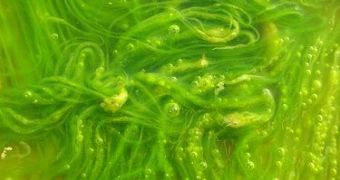Algae are starting to more and more preoccupy scientists, as strains can potentially produce 10 times or more fuel than the corn used in making ethanol or the soybeans that produce biodiesel. They also can be produced basically anywhere, so food production is not likely to be affected. As algae feed on carbon dioxide, they also could help reduce greenhouse gas, slowing down global warming.
In Sapphire Energy's laboratories, algae are kept in tubes as native genes are being tweaked and foreign genes are being spliced into algae. Inside the tubes there is a struggle for survival of the strongest algae, as the fastest-growing strains will be selected. The superalgae will be used to convert sunlight and carbon dioxide into lipids and oil that will later become diesel or jet fuel.
Mike Mendez, a co-founder and vice president for technology at Sapphire Energy, the owner of the laboratory, says to New York Times: “We’ve probably engineered over 4,000 strains. My whole goal here at Sapphire is to domesticate algae, to make it a crop.”
This is the common goal of several academic laboratories and companies, as algae could literally be the new green energy. Most of them use genetic engineering or chemically induced mutations to improve their functions.
Matthew C. Posewitz, assistant professor of chemistry at the Colorado School of Mines who has written a review of the field says that “there are probably well over 100 academic efforts to use genetic engineering to optimize biofuel production from algae. There’s just intense interest globally.”
However these genetically engineered algae worry some experts, because of the extremely important role that they play in our ecosystem. As algae produce a very high quantity of oxygen on earth and are necessary for the marine food chain, experts prone precaution. Gerald H. Groenewold, director of the University of North Dakota’s Energy and Environmental Research Center, is trying to organize a study of the risks. “We are not saying don’t do this,. We say do this with the knowledge of the implications and how to safeguard what you are doing.”
Scientists like Stephen Mayfield, professor of biology at the University of California, San Diego, and co-founder of Sapphire downplay and add: “Everything we do to engineer an organism makes it weaker. This idea that we can make Frankenfood or Frankenalgae is just absurd.” They say that for the past 35 years there have been no environmental problems, even though some genetically engineered organisms are likely to have escaped from labs.
Still, some more worried researchers like genetic scientist J. Craig Venter say that “about 40 percent of the oxygen that you and I are breathing right now comes from the algae in the oceans. We don’t want to mess up that process.”
The Environmental Protection Agency, which now regulates genetically engineered microbes under the Toxic Substances Control Act, is likely to regulate genetically engineered algae production, in open ponds or in enclosed bioreactors.

 14 DAY TRIAL //
14 DAY TRIAL //